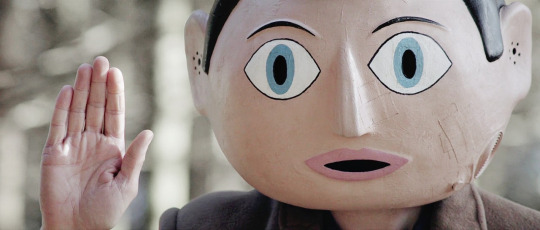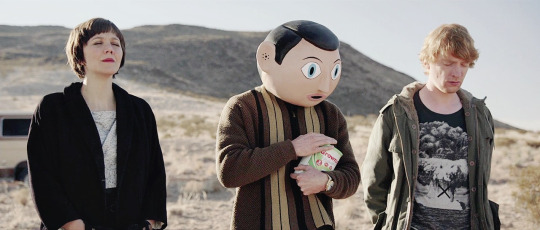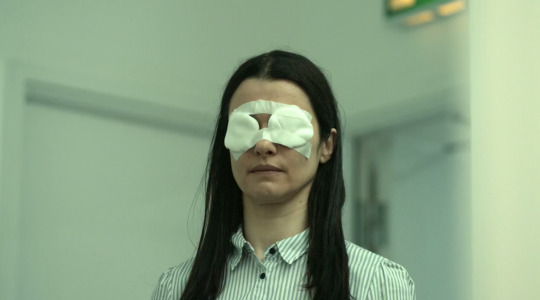Photo




It’s been another year, and you haven’t gotten around to professing your feelings yet. What better way to do it than using last week’s detection of gravitational waves?
14 notes
·
View notes
Photo










Well, normal faces are weird, too. You know, the way they’re smooth… smooth… smooth… and blech! You know? All bumpy and holes, I mean, what are eyes like? It’s like a science fiction movie. Don’t get me started on lips. Like the edges of a severe wound. - Frank (2014)
3K notes
·
View notes
Quote
The floorboards creaked under my weight. There were books everywhere. There were pens, and a blue glass vase, an ashtray from the Dolder Grand in Zurich, the rusted arrow of a weather vane, a little brass hourglass, sand dollars on the windowsill, a pair of binoculars, an empty wine bottle that served as a candle holder, wax melted down the neck. I touched this thing and that. At the end, all that’s left of you are your possessions. Perhaps that’s why I’ve never been able to throw anything away. Perhaps that’s why I hoarded the world: with the hope that when I died, the sum total of my things would suggest a life larger than the one I lived.
Nicole Krauss, The History of Love
9 notes
·
View notes
Photo

From the first day I saw her I knew she was the one
She stared in my eyes and smiled
For her lips were the colour of the roses
That grew down the river, all bloody and wild
The Lobster (2015)
43 notes
·
View notes
Photo

David Markson, Wittgenstein’s Mistress
5 notes
·
View notes
Quote
The test of a first-rate intelligence is the ability to hold two opposed ideas in mind at the same time and still retain the ability to function.
F. Scott Fitzgerald, The Crack-Up
77 notes
·
View notes
Quote
If I could live my life again, I wouldn’t try to be so perfect. I’d be more relaxed. I’d take fewer things seriously, I’d be less hygienic, I’d take more risks, I’d take more trips, I’d watch more sunsets. I’d eat more ice creams and less lima beans, I’d have more real problems and less imaginary ones. Of course I had moments of happiness but, if I could go back, I’d try to only have good moments. For if you didn’t know, this is what life is made of…only moments. Don’t lose this one right now.
Not Jorge Luis Borges
580 notes
·
View notes
Photo

Jennifer Laura Palmer, Building Upon the Past, Mixed Media on Paper, 2015.
22 notes
·
View notes
Photo

"Fig. 81. Relief Der Funktion ...," from the notorious "Funktiontafeln mit Formuln und Kurven" by Jahnke and Emde. Published for the first time in 1906 these two Germans didn't have any computers to do their calculations, so they graphed abhorrent functions like this one by hand and head. Back in the day their books were very widely used, today they're remembered mostly for their unparalleled accuracy.
4 notes
·
View notes
Photo


(The Seventh Seal by Ingmar Bergman)
21 notes
·
View notes
Photo

Edward Steed, The New Yorker, January 25, 2016
15 notes
·
View notes
Photo

Scleractinian corals, Ernest Haeckel, 1904
2 notes
·
View notes
Text
The Art of the Instruction
The following is an English translation of an essay "Algoritmes uit de kunst" written by Julius de Hond and recently published on the Dutch website deFusie.net. We explore the relationship between artistic intention and merit in the context of art that is produced through more abstract or algorithmic means. In particular, we focus on the GIF medium and how it serves as an artistically rich platform for computer generated graphics. Enjoy!
——————————————
The Art of the Instruction
By Julius de Hond & Intothecontinuum
How artistic is computer-generated art? Does an image, rendered by a microprocessor controlled by a set of predefined functions, possess the same qualities one could ascribe to a painting or a piece of music? Ever since the advent of computers in the 1950s, a movement characterized by an important role for the instruction has flourished. Its early propagators include, for instance, John Whitney, one of the first animators to use a computer. To a more abstract extent Sol LeWitt also comes to mind; he only wrote down meticulous instructions for some of his wall drawings, relying on others to carry them out. The work of these artists is characterized by a shift in the locus of artistic meaning from the sensory plane towards the conceptual description of a work. In other words: these artists do not attempt to directly create a sensory experience, but have removed the step of creation to another, more abstract, realm. Their work begs the question: Who is the artist? Is it the person who wrote down the instructions for the artwork? Or is it the person directly responsible for what we see and hear? In these cases the definition of the artwork itself becomes obfuscated; after all, everything we experience is encoded in a set of instructions, but on the surface these instructions contain only the slightest aesthetic element.
LeWitt’s instructions, spelled out next to one of his wall drawings, can still pique a viewer’s interest. They possess a certain curious quality and tell the story of his method of going about the creation of an artwork. This curiosity is largely absent from the instructions that early computer pioneers—such as Whitney—used to generate their work. Whitney used a coding language, which is completely unintelligible to an uninitiated audience. Even though all the information to generate the animation is contained within the code, extracting it would require either the rendering of a computer, or a painstaking examination by the audience. Therefore we would (perhaps naïvely) be inclined to say that the artistic meaning is located entirely in the output, because that part of the work is easiest to understand.
Fifty years later the advent of several software packages and image formats makes a reëxamination of some of these questions interesting. Thanks to e.g. the Graphics Interchange Format (GIF) it has become possible for virtually anyone to create a simple animation that’s looped infinitely; a fact that is often employed to a somewhat ironic extent on meme aggregators such as 9gag. Whereas the artistic content of most of these animations is questionable, the looped GIF does allow for some particularly beautiful animations with no discernible beginning or end. In order to get an animation to do what you want, you have to be comfortable with coding languages, so it is not entirely surprising that a lot of these GIF artists hail from areas such as mathematics, physics, and computer science.
There is an important difference between the creation of animations and the creation of other, perhaps more ordinary, works of art. This is caused by an extra step of translation: a painter has a certain sensation or image they want to express and is not very much restricted by their medium. The programmer, however, is restricted by the functions available in whatever software package they are using, and thus has to translate the image in their mind into whatever tools are available. These functions do not “look” in any way like the desired output, making the entire process a lot more abstract. As a result, the creative process becomes much more like trial and error: if the output does not look as desired, the input has to be changed. This is a lot like science: a hypothesis (here the input code) is tested and adjusted as the result of an experiment (here the output of the computer) does or does not fit.
In the light of these GIF animations the question of the locus of artistic meaning becomes slightly more complicated. In the cases of Whitney and LeWitt the translation from instruction to result was still reasonably understandable, but this isn’t at all the case for the creation of a GIF. To create a GIF, programmers write and compile code, but after this last step everything is out of their hands. Via a complicated route of translation, the input is translated into machine code, which contains the instructions for the generation of an image or animation. The entire process is much more involved, meaning that it becomes less clear who the artist is. Is it the programmer? Is it the software engineer responsible for the software? Or is it the physical computer, taking a similar role as the individuals who executed LeWitt’s wall drawings?
The situation is perhaps somewhat analogous to that of a composer who writes music for an orchestra. At each stage of a musical composition there is some artistic merit. First of all, the composition itself can be naturally regarded as a piece of art; it can be thought of as being analogous to a GIF. But even before the composition comes into its complete existence, there is a composer who manifests it. This act of composing can also be seen as an art form since it can serve as a means of expression. This is the point where what constitutes an art becomes inherently ambiguous. Most people, including composers themselves, would probably consider the composer an artist. In our analogy, composing would correspond to creating animations. There are many ways to make animations, some of which are highly creative and of clear artistic merit, but it is in no way obvious that the act of using computer code to generate animations is, in and of itself, artistic. Perhaps to some this is clear, but a certain level of appreciation of the abstraction involved in coding seems to be a requirement.
After a piece of music has been composed it is brought to life by an orchestra. Musicians and conductors are often praised for their interpretation and execution of a composition, so it seems safe to say that most think this part of the process includes artistic value, too. We can think of GIFs as renditions of geometric shapes which are not “owned” by the programmer, just as “Beethoven’s 7th” is not “owned” by the orchestra performing it. The entire performance, finally, would be impossible without the instruments that are used by the musicians to render the composition. Although the artistic value of a finely made instrument may not be clear to all, there is certainly some room for appreciation of a certain design. Similarly, if one knows enough about programming and engineering, it is possible to appreciate the way a computer or a software package was made.
When listening to a composition the listener is directly aware of the artistic stages that preceded the experience they are having at that particular moment. They are aware of the musicians, the composers, and the piece itself, and so they are able to appreciate the artistic merit involved in each step. By analogy, this suggests a way to appreciate the creation of a GIF: it is the result of a complicated interaction between individuals, mathematics, and programming. To differing degrees, each of these steps contains a solution to the problem encountered when trying to express a particular feeling or thought in a very unnatural medium. It is the entanglement of the different levels that exist between the programmer’s instructions and the computer’s output that constitutes the artistic merit in these cases
59 notes
·
View notes
Photo

Edward Hopper, Office in a Small City, 1953, oil on canvas, 71.1 x 101.6 cm
8 notes
·
View notes
Photo

Paul Kirchner, The Bus, 1978-85
5 notes
·
View notes
Photo

Bill Evans
6 notes
·
View notes
